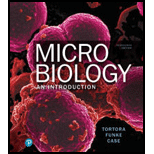
Microbiology: An Introduction Plus Mastering Microbiology with Pearson eText -- Access Card Package (13th Edition) (What's New in Microbiology)
13th Edition
ISBN: 9780134688640
Author: Gerard J. Tortora, Berdell R. Funke, Christine L. Case, Derek Weber, Warner Bair
Publisher: PEARSON
expand_more
expand_more
format_list_bulleted
Concept explainers
Question
Chapter 23, Problem 4CAE
Summary Introduction
Case summary
Six peoples stayed in a cabin overnight developed fever in the month of August and September, two recovered without treatment , three recovered with tetacycline therapy but one patient admittted in hospital with septic shock.
Expert Solution & Answer
Want to see the full answer?
Check out a sample textbook solution
Students have asked these similar questions
Explain in a small summary how:
What genetic information can be obtained from a Punnet square? What genetic information cannot be determined from a Punnet square?
Why might a Punnet Square be beneficial to understanding genetics/inheritance?
In a small summary write down:
Not part of a graded assignment, from a past midterm
Chapter 23 Solutions
Microbiology: An Introduction Plus Mastering Microbiology with Pearson eText -- Access Card Package (13th Edition) (What's New in Microbiology)
Ch. 23 - Identify the portals of entry for Trypanosoma...Ch. 23 - Prob. 2RCh. 23 - Prob. 3RCh. 23 - Complete the following table.Ch. 23 - Complete the following table.Ch. 23 - Prob. 6RCh. 23 - Compare and contrast cat-scratch disease and...Ch. 23 - Prob. 8RCh. 23 - Prob. 9RCh. 23 - Prob. 10R
Ch. 23 - Use the following choices to answer questions 1...Ch. 23 - Prob. 2MCQCh. 23 - Prob. 3MCQCh. 23 - Prob. 4MCQCh. 23 - Prob. 5MCQCh. 23 - Which of the following is not a tickborne disease?...Ch. 23 - Prob. 7MCQCh. 23 - Prob. 8MCQCh. 23 - Prob. 9MCQCh. 23 - Prob. 10MCQCh. 23 - Prob. 1ACh. 23 - What is the most effective way to control malaria...Ch. 23 - The hunter picked up the front paws for good luck....Ch. 23 - Prob. 2CAECh. 23 - Prob. 3CAECh. 23 - Prob. 4CAECh. 23 - A 67-year-old man worked in a textile mill that...
Knowledge Booster
Learn more about
Need a deep-dive on the concept behind this application? Look no further. Learn more about this topic, biology and related others by exploring similar questions and additional content below.Similar questions
- Noggin mutation: The mouse, one of the phenotypic consequences of Noggin mutationis mispatterning of the spinal cord, in the posterior region of the mouse embryo, suchthat in the hindlimb region the more ventral fates are lost, and the dorsal Pax3 domain isexpanded. (this experiment is not in the lectures).a. Hypothesis for why: What would be your hypothesis for why the ventral fatesare lost and dorsal fates expanded? Include in your answer the words notochord,BMP, SHH and either (or both of) surface ectoderm or lateral plate mesodermarrow_forwardNot part of a graded assignment, from a past midtermarrow_forwardNot part of a graded assignment, from a past midtermarrow_forward
- please helparrow_forwardWhat does the heavy dark line along collecting duct tell us about water reabsorption in this individual at this time? What does the heavy dark line along collecting duct tell us about ADH secretion in this individual at this time?arrow_forwardBiology grade 10 study guidearrow_forward
arrow_back_ios
SEE MORE QUESTIONS
arrow_forward_ios
Recommended textbooks for you
- Case Studies In Health Information ManagementBiologyISBN:9781337676908Author:SCHNERINGPublisher:Cengage
 Comprehensive Medical Assisting: Administrative a...NursingISBN:9781305964792Author:Wilburta Q. Lindh, Carol D. Tamparo, Barbara M. Dahl, Julie Morris, Cindy CorreaPublisher:Cengage Learning
Comprehensive Medical Assisting: Administrative a...NursingISBN:9781305964792Author:Wilburta Q. Lindh, Carol D. Tamparo, Barbara M. Dahl, Julie Morris, Cindy CorreaPublisher:Cengage Learning

Case Studies In Health Information Management
Biology
ISBN:9781337676908
Author:SCHNERING
Publisher:Cengage





Comprehensive Medical Assisting: Administrative a...
Nursing
ISBN:9781305964792
Author:Wilburta Q. Lindh, Carol D. Tamparo, Barbara M. Dahl, Julie Morris, Cindy Correa
Publisher:Cengage Learning